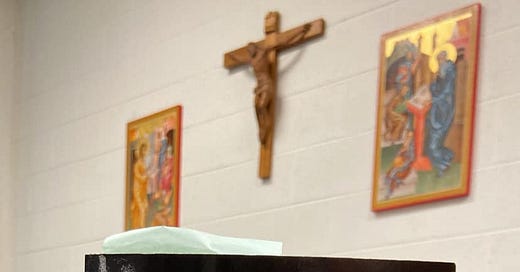We have made our way through the “Introduction” and the first 17 pages of Chapter 1 of Fleming Rutledge’s The Crucifixion. If you have just picked up a copy the book there is still time to get caught up in order to finishing reading by the end of Lent. The reading schedule for the week is at the end of this post.
But before we get to the reading this week, let me share some thoughts from what I have read so far.
From the beginning I have seen exactly what so many others have said about Rutledge. She is a keen theologian and a compelling writer. I have pages in these opening fifty pages or so where nearly every sentence is underlined.
I appreciate that Rutledge is writing from the perspective of a pastor and a preacher. It’s clear that she is deeply interested in writing for those of us in vocational pastoral ministry so, as a pastor, it feels like she is writing just for me.
If you are neither a preacher nor a pastor, don’t worry, there is still much to learn about the meaning of the death of Jesus in this book! Rutledge is writing for the benefit of all followers of Jesus. She writes:
“This volume is designed to honor the complexity of the New Testament witness while, at the same time, encouraging the reader to trust that the message of the crucified Lord is directed straight to every heart with the enabling and liberating power of the Holy Spirit” (23).
She wants to reclaim the scandal of the cross in a culture where the preaching of the cross has become sanitized and repacked as an “inspirational uplift” in churches where preaching is “sunlit, backlit, or candlelit” (3). She wants to reposition our thinking about the cross in the grand biblical narrative, discussing what we know as “atonement theories” in the context of the language of Scripture. We need context to make sense of the cross, but even reading key passages on the death of Jesus in the New Testament require interpretation.
Rutledge intends to look at each biblical image or motif related to the death of Jesus and she invites us to join her with joy because the cross is central to our faith. The cross reveals to us who God is and the “cruciform path” is the way to the very heart of God (37).
In the opening chapter she identifies Gnosticism as a challenge to understanding the cross, an enemy to the true orthodox Christian faith because it devalues the material world locating salvation in obtaining certain kinds of special knowledge. “Gnosticism,” she writes, “in all its many forms prevents us from understanding the biblical witness to the crucifixion” (54). From the obstacle of Gnosticism, she turns to discuss the crucifixion in the gospels
and that is where we will begin this week!
Here is the reading schedule this week:
Monday, February 27: Pages 59-74
Tuesday, February 28: Pages 74-90
Wednesday, March 1: Pages 91-105
Thursday, March 2: Pages 106-122
Friday, March 3: Pages 123-140
Saturday, March 4: Pages 141-156
Sunday, March 5: No scheduled reading unless you need to catch up on what you didn’t get read this week
I have enjoyed reading some of your quotes and thoughts on social media. Be sure to post with the hashtag #ReadingRutledge.






It seems she has few “sacred cows” and I find myself wondering if she might skewer some of mine….both people and beliefs!! But her engaging style has me soldiering on!! I’ve noticed this bit of aching wonder as I’ve read….”where does faith in Jesus show up as Gnosticism or consumerism?! Is the “word of the cross” part of my theology?
Hands down the best explanation and definition of Gnosticism I have read! Loving her sharp, pointed writing style...I am impressed 👍